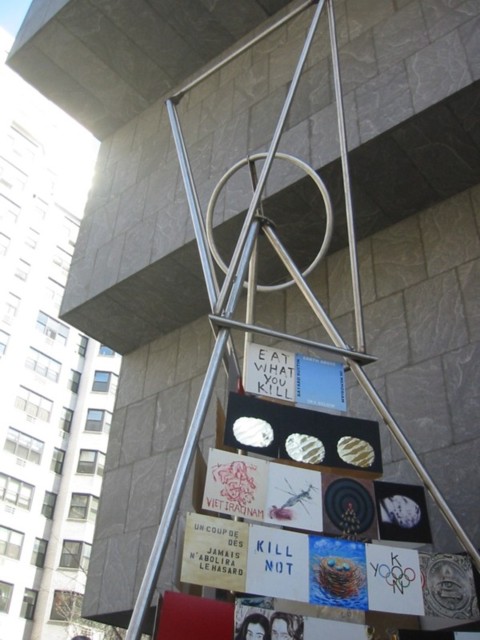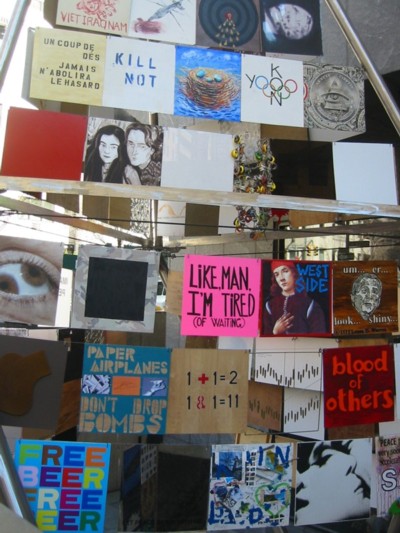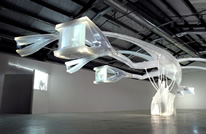
Tiravanija and deSuvero, etc.: Peace Tower, 2006
Better Than An Art Fair; Faster, Bigger, Darker
What is there left to say? The Whitney Biennial (through May 28) always has enough for everybody … to hate. I, however, being of an infuriatingly sunny disposition, always find something to love.
Two innovations this time are of note. The Biennial has a title: “Day for Night,” after Francois Trouffaut’s film (not his best) L’Nuit Americaine. “Day for night,” translated into French as “American night,” means filming in daylight with filters to create the look of nighttime. Does this mean that what some now perceive as The American Night is an illusion? Is the war in Iraq only a Hollywood fantasy?
These are dark times.
I have taken to this proclamation, whispering it in my deepest, most ominous voice, directly into the ear of my victim, usually someone who is complaining or ranting. I don’t think I have to explain.
So if the two Biennial curators, Chrissie Isles of the Whitney and Philippe Vergue of the Walker Art Center, intend to capture this darkness (as they seem to indicate) then there is indeed a sociological and perhaps a political statement being attempted.
“Day for Night” is a catchy title, open to many meanings. The prevalence of films, videos, and mass media in the Biennial offering, is the most superficial. But the theme is not rigorously (or rigidly) defined orworked out. The Biennial, if nothing else, is a large group show and prey to all the difficulties inherent in that form. A title (or a theme) is only a partial solution to the inherent incoherence of multiple art sensibilities forced to sit and behave under one tent. The title/theme must be provocative, which is certainly not a problem here. But although ourtendancy is to be indulgent to a first-time slant, we are dealing with a catch-all phrase. Almost anything could fit under this poetic rubric.
Are there other, perhaps less poetic themes that might prove more useful? Future Biennial might be media-specific. In the deep dark past the Whitney alternated painting and sculpture surveys, annually. A painting Biennial? A projected-art Biennial? Why not? Do we really want, as is presently the case, to be forced to compare soup to nuts? Paintings to full-scale Hollywood-type film-art? Pierre Huyghe’s truly weird penguin movie A Journey That Wasn’t to Francesco Vezzoli’s delicious trailer for a non- existent remake of Gore Vidal’s Caligula? In terms of the former, this viewer’s love of arctic and Antarctic landscapes (rapidly melting, it turns out) was undercut by an afterimage of that stupid, other penguin movie, The March of the Penguins, beloved by right-wing proponents of so-called family values. In terms of the hilarious Caligula, it’s always worthwhile even just to get a glimpse of Karen Black, the only movie star (other than Dan Duryea) I have ever wanted to meet.
Ironically both products are flawed by production values. As with a Matthew Barney film, I see dollar signs imbedded in every take, cut, costume, prop. Production values, may we be saved from production values by a strong dose of Arte Povera, soon! No one ever said it was cheap to be an artist, but it seems to be getting increasingly expensive, and I do not mean merely the cost of lofts. We always suspected that what we call art is art for the rich, but it is now dawning on some that perhaps now art can only be made by the rich or those with immensely creative fundraising capabilities.
Geography could be another Biennial theme. Artists of the American South, the Southwest, the Pacific Northwest. Or, since we are consciously international (i.e. global) why not a Biennial made up entirely of Latin American artists? Or Australians?

Peace Tower (detail), 2006
But Is It International?
The Biennial is now officially “international.” But, by the way, when you go to the Biennial on-line catalogue the statistics are less than awesome:
East Coast – 34
West Coast – 17
Central U.S. – 9
Puerto Rico – 3
International – 11
No Region – 7
“No Region” is my favorite, and not only because it includes jazz great, the late Miles Davis and the Artopia-approved Critical Art Ensemble. “No Region” suggests a parallel universe, which more and more, like Artopia, may be the best place to be.
Traditionally the Biennial has been limited to U.S. artists, which always involved a little nit-picking. Out of necessity foreign-born artists (de Kooning, Rothko, etc.) were included. Modern art has always had an international or at least a North Atlantic bent. The term Euro-American Modern would be a blatant redundancy. Yet some important artists, although residing in the U.S., but technically not citizens, were excluded from the Whitney in the past.
Art is nomadic. Artists are nomadic. We are all citizens of Continental Airlines, Time-Warner, and Microsoft. The daily Existentional question is no longer “who am I?” but “where am I?”
National is international and local is national. In Phoenix last month, what did I see? Two splendid exhibitions: Pat Steir at the Bentley Gallery and a Petah Coyne survey at the Scotsdale Museum of Contemporary Art. Where was I? Hadn’t I just seen (and written about) Coyne at the Sculpture Center in Queens? Three years ago when I was in Berlin, whose work did I see at the Berlin Guggenheim? Richard Artswager. I had to go all the way to Berlin to see Artswager?
There is no longer any regional art or any national art; it is all “American” art even when it’s not made by an American. Is this why all Chinese installation artists produce works that could have been made at the Chicago Art Institute or Yale or in Dusseldorf? That’s what globalism means. The dark side of globalization is that everywhere art is the same.
In the late 19th and early 20th centuries art and artists came from Russia, Italy, Spain, Scandinavia, The Netherlands, Latin America and so forth, to Paris. Then modern art moved to New York. Now, building on what happened here, modern art spreads out again, around the world, and even back to Europe. It is one big, gigantic conversation; members of one big family at each other’s throats. All commodities are by their very nature global; art is a commodity. Global is not news; the end of the gallery system, struck down by art fairs, is.
Or may be soon.
Dealers will always be required. A dealer once explained to me why artists selling directly out of their studios might not only be breaking implied contracts and cheating their reps, but were risking doom: collectors really didn’t like to deal with grubby artist types. I think it is the other way around: artists prefer not to deal with up-tight, uninformed, money-grubbing, investor/collectors. Better to let the dealers do the dirty work, bless their souls. Nevertheless, I predict that art dealers, like artists, will be homeless, stateless, nomadic. As an art sales rep, moving from one art fair to the next, your website is your only permanent address.

Peace Tower (detail), 2006
Elder Art (You Heard It Here First!)
Finally, I suggest that a larger number of older, accomplished artists be included in future Biennials as was once the case in ancient times. It was always a big boost for newcomers to be shown next to elders, rather than just among other tots and toddlers. Here the best we can say is that we have an anti-war poster by Richard Serra, Mark diSuvero’s recreated 1963 peace tower (with Rirkrit Tiravanija) and scattered work by musicians (Tony Conrad), filmmakers (Kenneth Anger and Michael Snow) and an underground celebrity (Taylor Mead).
L.A. Noir


Servo: Untitled Projection Apparatus, 2006
Like many, I lack the patience to watch most time-locked, media presentations in galleries and museums. Is it hyperactive me? The form? Or the ill-begotten mini-movies themselves? I was also in L.A. last month and did see “Dark Places” (through April 22) at the Santa Monica Museum of Art. There, a 76-artist, time-art presentation beguiled me. As at the Whitney, darkness is a theme, but the moving images are presented simultaneously on monitors at the ends of the tentacles of the central presentation module, or projected from same. This strange structure by the Servo architecture collective, is the new Medusa. The art part shifts from the individual offerings to curator Joshua Dechter’s overall bath of moving images, which — although probably unfair to the artists — is deliciously overwhelming. The sum is more than the parts.
FOR EMAIL ARTOPIA ALERTS: CONTACT PERREAULT@AOL.COM.
